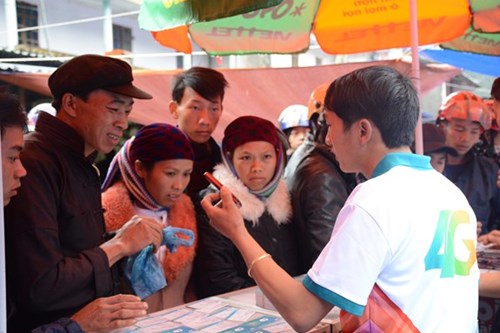International investment - a strategic pillar
In the 12-year development phase from 2018-2030, Viettel has set the target to maintain the growth rate of 10-15%. At this rate, it is estimated that by 2030, Viettel might have reached the target of USD 85 billion of revenue in total. In more details, as announced by Viettel, the revenue proportion of the telecommunications sector will account for 55%; that of the hi-tech sector, 25% (with more than 50% from export value); innovative and creative investment sector, 10% and traditional areas, 10%.
    |
 |
|
Mytel is developing rapidly in Myanmar |
People may doubt the ambitious target of USD 80 billion. However, from the prospects of the global business panorama and the advent of Industry 4.0, the figure is not too far to reach. First of all, with the advent of Industry 4.0, Viettel now stands a lot of advantages thanks to the resources and achievements it gained in the previous stage. The market will decide the success or failure of a business. At present, Viettel is operating in 11 markets with the total population of 240 million people in three continents (Asia, Africa and America), in which it holds the biggest proportion of the market-shares in five markets.
So far, investment projects in 8 out of 11 countries of Viettel have earned profits, among which three have paid back (Laos, Cambodia, and Timor Leste) and reached the top place in the telecommunications sector, bringing the profits of 4-5 times of the investment values. In 2017, Viettel’s revenue from overseas markets reached nearly USD 1.7 billion, increasing by more than 38% compared to 2016, or more than nine times of the average growth rate of the global telecommunications sector.
International investment is seen as one strategic pillar; therefore, Viettel has set the target to reach the 400-500 million, or 600-700 million-strong, market. Boosting investment overseas is a strategic step for the long-lasting operation of Viettel in the future while maintaining its growth and revenue as the domestic market is reaching its limit and traditional income is decreasing.
Revenue restructuring
One of the highlight in the revenue structure of Viettel in the Industry 4.0 period lies in the hi-tech industry. From a pure telecommunications enterprise, so far Viettel has added three other new business areas to its operation, expanding its space of development. They are the cyber-security, the electronic telecommunications and the hi-tech defense industries.
    |
 |
|
Viettel has set the target that 70% of the group’s telecommunications infrastructure will be mastered by the group by 2020 |
Viettel has clearly set its targets: To be one of the top 50 defense industry enterprises; one of the 20 biggest electronic telecommunications groups; and one among the top-50 list of cyber-security firms in the world. As for the defense industry area, Viettel will boost investment in developing specialized dual-use technologies.
In order to realize the new strategy, Viettel leaders revealed that the group has long developed and put into operation five dual-use research institutes, two electronic and mechanic companies, two cyberspace and cyber-security centers, employing 5,000 laborers with the R&D budget reaching VND 4,000-5,000 (more than USD 172 million) per year.
The two areas of electronic telecommunications and hi-tech technologies alone have brought Viettel VND 12,000 billion (more than USD 518 million), equal to the international investment value of Viettel in the last 10 years.
As for the civil area, Viettel has researched, produced and put into operation most important components of the telecommunications infrastructure of the group in Vietnam and overseas markets. For example, Viettel successfully developed and operated its own online charging system (vOCS 3.0), Mobile Service Switching Center (iMSC), Evolved Packet Core (vEPC), IP Multimedia Subsystem (vIMS), etc.
Noteably, the real-time charging system of Viettel (applied in six countries with 140 million subscribers) is capable of managing 24 million subscribers per site, doubling the capacity of other systems in the world. The success of the vOCS makes Vietnam one of the biggest OSC producers, for there have been only around 20 providers in the world now capable of developing real-time charging systems, three among which are Amdocs, Ericsson and Huawei.
For terminal equipment, Viettel successfully developed its Marco cell 4G (eNodeB) and Small cell 4G transmitters, optical site routers, etc., which is considered one of the breakthroughs of Viettel. At present, there are only five telecommunications equipment providers in the world. By mastering 4G technologies and equipment, Viettel has set the target that 70% of the group’s telecommunications infrastructure will be mastered by the group by 2020, independent from other providers, bringing a stable foreign currency income.
These hard jobs require huge investment but they in turn will bring new revenue worth billions of USD. In the history of the group, Viettel has always made incredible deeds. From the revenue of just billions of VND, now the group has made billions of USD. Its revenue increased by 2.7 times (from VND 92,000 billion, or nearly USD 4 billion, to VND 252,000 billion, or nearly USD 11 billion) in just eight years.
Reaching the revenue USD 80 billion is really a challenge for the group. However, only by embarking on this path will Viettel become a global technology-business group, maintaining the leading position in Vietnam in the telecommunications and hi-tech industries, striving to be listed in the top 150 businesses in the world by 2030, top 10 telecommunications and information technology firms, top 20 electronic telecommunications enterprises, and top 50 cyber-security companies.
Translated by Huu Duong